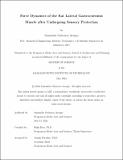Force Dynamics of the Rat Lateral Gastrocnemius Muscle after Undergoing Sensory Protection
Author(s)
Gutierrez Arango, Samantha
DownloadThesis PDF (26.82Mb)
Advisor
Herr, Hugh
Terms of use
Metadata
Show full item recordAbstract
The sensory protection procedure, involving the reinnervation of a motor-denervated muscle with a sensory nerve, has shown promise in preserving muscle function and structure. This thesis investigates the impact of sensory protection on the force dynamics and muscle architecture of the lateral gastrocnemius muscle in a rat animal model. Using a within-subjects experimental design, this preliminary study compared Sensory Protected and contralateral Intact muscles within a cohort of four rats. In situ ergometry experiments suggest that normalized Force-Velocity-Power (FVP) properties may be largely preserved after sensory protection, with small percent differences in normalized FVP curves between the Sensory Protection muscles versus contralateral muscle controls. Key FVP parameters such as peak velocity and specific peak power exhibited higher percent differences for the Sensory Protected muscles, but lower percent differences in pennation angles and physiological cross-sectional area, suggesting that sensory reinnervation may influence muscle structure and fundamental force dynamics. Despite limitations, such as the small sample size, the study lays the groundwork for future research investigating the cellular and molecular mechanisms underlying the observed changes. The findings highlight the potential of Sensory Protected muscles as biological actuators in prosthetic devices, and suggest that sensory reinnervation may be a promising strategy to maintain or restore muscle function in individuals with motor impairment.
Date issued
2024-05Department
Program in Media Arts and Sciences (Massachusetts Institute of Technology)Publisher
Massachusetts Institute of Technology